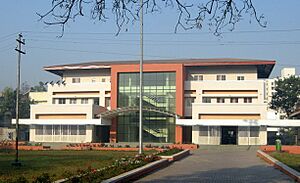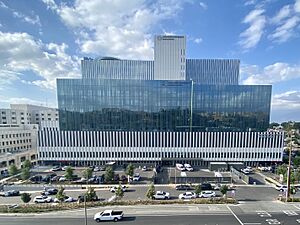Seventh-day Adventist Church facts for kids
Quick facts for kids Seventh-day Adventist Church |
|
|---|---|

The Seventh-day Adventist logo
|
|
| Classification | Protestant |
| Orientation | Adventist |
| Theology | Seventh-day Adventist theology |
| Polity | Presbyterian/Episcopal |
| President | Ted N. C. Wilson |
| Region | Worldwide |
| Founder |
|
| Origin | May 21, 1863 Battle Creek, Michigan, U.S. |
| Branched from | Millerites |
| Separations |
|
| Congregations |
|
| Members | 22,234,406 |
| Pastors | 20,924 |
| Hospitals | 229 |
| Nursing homes | 129 |
| Aid organization | Adventist Development and Relief Agency |
| Primary schools | 6,623 |
| Secondary schools | 2,640 |
| Tertiary institutions | 118 |
| Other name(s) | Adventist church, SDA (informal) |
The Seventh-day Adventist Church (often called SDA) is a Christian church. It is known for observing Saturday as the Sabbath, which is the seventh day of the week. This church also believes that Jesus Christ will return to Earth very soon.
The Seventh-day Adventist Church started in the United States in the mid-1800s. It officially began in 1863. One of its important co-founders was Ellen G. White. Her many writings are still highly respected by the church today.
Many of the church's beliefs are similar to other Christian groups. For example, they believe in the Trinity (God as Father, Son, and Holy Spirit). They also believe the Bible is completely true. Some special beliefs include that people are unconscious when they die. They also believe in an "investigative judgment" that started in 1844.
The church focuses a lot on health and diet. Many members choose to be vegetarian and follow kosher food laws. They see the body, soul, and spirit as one complete unit. They believe God created the world in six days and rested on the seventh. Marriage is seen as a lifelong bond between a man and a woman. The return of Christ and the resurrection are also key beliefs.
The church is led by a group called the General Conference of Seventh-day Adventists. Smaller areas have their own leaders. As of 2016, the Seventh-day Adventist Church is one of the fastest-growing churches globally. It has over 22 million baptized members. It is active in over 215 countries. The church runs many schools, hospitals, and publishing houses. It also has a humanitarian aid group called the Adventist Development and Relief Agency (ADRA).
The Church's Story
The Seventh-day Adventist Church grew from a movement in the 1840s. This movement was led by William Miller in New York. Miller believed that Jesus would return to Earth between 1843 and 1844. He based this on his study of the Bible.
In 1844, many of Miller's followers expected Jesus to return on October 22. When this did not happen, it was called the "Great Disappointment". After this, some followers, like Hiram Edson, believed Miller's dates were right. However, they thought his understanding of what would happen was wrong. They came to believe that Jesus had entered a special place in heaven, not returned to Earth. This idea led to the teaching of the "investigative judgment." This is a process where God judges everyone to decide who will be saved. This judgment began in 1844.
Why Do Adventists Keep the Sabbath?
As the early Adventist movement grew, they discussed the correct day for rest and worship. Joseph Bates was a strong supporter of keeping the Sabbath. He learned about the Sabbath from a preacher named T. M. Preble. This idea was slowly accepted by the group. It was featured in the first church newspaper in 1849.
How the Church Was Organized
For about 20 years, the Adventists were a small, loose group. They connected mainly through a newspaper published by James White. They believed in the Sabbath, the heavenly sanctuary, and that people sleep when they die. They also expected Jesus to return soon. Key leaders included Joseph Bates, James White, and Ellen G. White. Ellen White became very important. Her many visions convinced others that she had the gift of prophecy.
On May 21, 1863, the Seventh-day Adventist Church officially started in Battle Creek, Michigan. The church headquarters later moved to Silver Spring, Maryland. In the 1870s, the church began missionary work. Its membership grew quickly. By 1880, it had 16,000 members. By 1901, there were 75,000 members. The church also started colleges, hospitals, and publishing houses. By 1945, the church had over half a million members worldwide.
What Seventh-day Adventists Believe
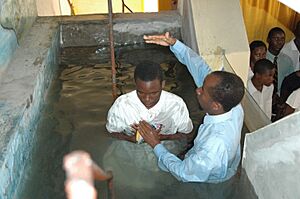
The church first shared its beliefs in 1872. Early leaders had different ideas about God. Over time, the church studied the Bible more deeply. They came to believe in the Trinity, which means God is one being in three persons: Father, Son, and Holy Spirit. This belief is now a core part of their faith.
The official teachings of the Seventh-day Adventist Church are found in its 28 Fundamental Beliefs. These beliefs were first adopted in 1980. An extra belief was added in 2005. Most of these beliefs are similar to other Protestant churches. Some unique Adventist beliefs include worshiping God on Saturday. They also believe in Ellen G. White's gift of prophecy. Another unique belief is the sanctuary doctrine.
The church believes God created Earth in six days and rested on the seventh. New members are baptized by being fully immersed in water. They believe the Bible is the most important book. Adventists believe that when people die, they remain asleep until they are brought back to life. They believe that eternal life is given to those who accept Jesus as their Savior. They also believe that salvation comes only through Jesus. The church believes the "investigative judgment" happens in heaven before Jesus returns. They also believe in the Apocalypse, which will lead to Jesus' Second Coming.
How Adventists Live and Worship
Sabbath Activities
Adventists spend part of Friday getting ready for the Sabbath. This might include preparing meals and cleaning their homes. On Friday evening, many Adventists gather for worship. This helps them welcome the Sabbath.
Worship Service
The main weekly worship service is on Saturday. It usually starts with "Sabbath School." This is a time for small groups to study the Bible together. Adventists use a special lesson guide for this study.
After a short break, the community gathers for a church service. This service is similar to other Christian churches. It includes singing, Bible readings, prayers, and an offering. A sermon is a main part of the service. The music styles vary greatly around the world.
Holy Communion
Adventist churches usually have communion four times a year. It begins with a "foot washing" ceremony. This is called the "Ordinance of Humility." It reminds people to serve each other humbly, just as Jesus washed His disciples' feet. People usually separate by gender for this ritual. After this, they return for the Lord's Supper. This meal includes unleavened bread and unfermented grape juice.
Health and Eating Habits

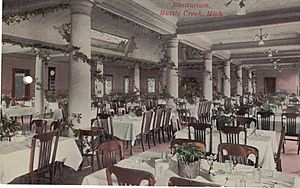
Since the 1860s, the Seventh-day Adventist Church has encouraged a vegetarian diet. Many members avoid pork, shellfish, and other foods listed as "unclean" in the Bible. Some Adventists also avoid processed foods and caffeine.
Adventist pioneers helped make breakfast cereals popular. John Harvey Kellogg created meat alternatives at the Battle Creek Sanitarium. He and Will Keith Kellogg invented corn flakes there. Will Keith Kellogg later founded the Kellogg's company. Other Adventist companies, like Sanitarium in Australia and New Zealand, also make healthy food products.
Studies show that Adventists often live longer than others. This is because they usually do not smoke. They also have a weekly day of rest and eat a healthy, low-fat, vegetarian diet. Loma Linda, California, is a "Blue Zone" known for its long-living residents. This is partly due to the many Adventists living there.
The U.S. military recognized Adventists' healthy lifestyles in 1954. Over 2,000 Adventists volunteered for "Operation Whitecoat." This was a medical research program to protect against biological weapons.
Marriage in the Church
Adventists define marriage as a lifelong promise between a man and a woman. They believe marriage was created by God at the beginning of the world. They see it as a special gift from God.
Dress and Fun Activities
Adventists have traditional views on how they dress and what they do for fun. They believe their choices should show Christ-like purity, health, and joy. They are encouraged to dress simply, modestly, and neatly. They also believe true beauty comes from a gentle spirit.
Adventists are against practices like body piercing and tattoos. They also avoid wearing jewelry like earrings and bracelets. Some also choose not to wear wedding rings, though this is not a strict rule for everyone.
Some Adventists avoid certain activities they see as spiritually harmful. These include dancing, rock music, and secular theater. However, studies show that many young Adventists in North America have different views on these standards. In 2000, the church passed a rule against gambling. The church encourages members not to gamble and does not accept money from it.
Helping Young People Grow
The church has special programs for children and youth. The Adventurer club is for children aged 4–9. It helps them learn about God, themselves, and the world. It also teaches them to be kind and serve others.
Pathfinders is a club for older kids, usually ages 10-15. It is similar to the Scouting movement. Pathfinders go camping, do community service, and learn leadership skills. They also have large gatherings called "Camporees." After Pathfinders, teens can join "Teen Leadership Training" and then the "Master Guide" program. These programs help them become leaders in the church.
How the Church is Organized
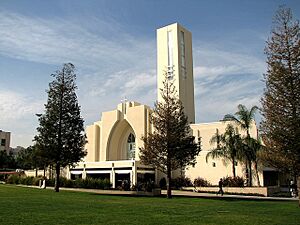
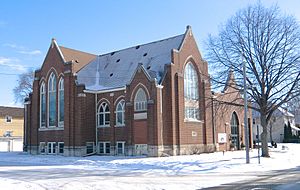
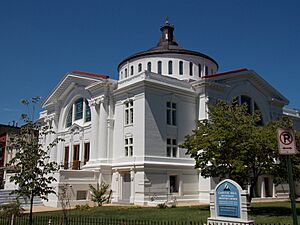

The Seventh-day Adventist Church has a system of organization with four main levels:
- The local church is where members worship. Every baptized Adventist can vote in their local church.
- Above the local church is the local conference. This group manages churches in a state or region. They hire ministers and handle church finances.
- Next is the union conference. This group oversees several local conferences.
- The highest level is the General Conference. It has 13 "Divisions" around the world. The General Conference makes final decisions for the church. Its main office is in Silver Spring, Maryland, USA.
Leaders for each level are chosen at special meetings called "sessions." For example, the president of the General Conference is elected every five years. Money collected from members is sent to the local conferences. This money is then used for various church needs.
Church Leaders and Pastors
The church's ordained leaders are called ministers or pastors. They are hired by the local conferences, not by individual churches. Pastors are assigned to lead one or more churches. After several years of service, pastors and elders can be ordained.
Local churches also have lay leaders. These include elders and deacons. Elders help with church management and provide religious leadership. Deacons help the church run smoothly and take care of church property.
Women in Leadership
The Seventh-day Adventist Church has had discussions about whether women can be ordained as pastors. In 1990 and 2015, the General Conference voted against ordaining women as pastors. However, some regions, especially in North America and Europe, have allowed women to be ordained as pastors. In 2012, there were 320 women pastors in the church worldwide. In 2013, a woman was elected president of a local conference for the first time.
Church Membership
The Seventh-day Adventist Church is one of the fastest-growing organizations in the world. Most of its growth comes from developing countries in Africa, Asia, and Latin America. In 2006, over 25 million people attended Adventist churches weekly. In 2011, it was reported to be the fastest-growing church in the United States.
By 2013, the church had over 17 million members. However, it was also reported that the church lost some members over a fifty-year period. In 2015, the church was the most racially diverse Christian group in the United States. In 2017, the church had members in almost every country. By 2019, there were 21 million baptized members worldwide. In 2020, membership growth slowed due to the COVID-19 pandemic.
Adventist Outreach and Service
Adventist mission work began in the late 1800s. Today, it reaches people in over 200 countries. Mission workers share the Christian message. They also promote health through hospitals and clinics. They run projects to improve living standards and provide help during disasters.
The church believes in sharing its message with everyone. They also strongly support religious freedom for all people.
Education
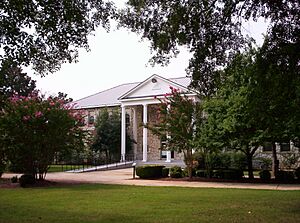
The Adventist Church runs a large school system globally. It has 7,598 schools, colleges, and universities. Over 1.5 million students attend these schools. It is the second-largest school system in the world, after the Roman Catholic Church.
Medical Care
The church operates a large network of hospitals, clinics, and health centers worldwide. These facilities are important for the church's health message and its global mission.
AdventHealth is the largest non-profit Protestant health care provider in the United States. It runs 53 hospitals in nine states.
Helping Others and Protecting the Earth
For over 50 years, the church has helped people through the Adventist Development and Relief Agency (ADRA). ADRA is a relief group that works in 125 countries. It helps during crises and works on projects to reduce poverty. ADRA is recognized by the United Nations.
The church also cares about the environment. They encourage a simple lifestyle. This means not over-consuming or creating too much waste. They believe in respecting nature and using the Earth's resources wisely.
Media Outreach
Adventists have used media to share their message for a long time. Early efforts included distributing newspapers and tracts. In the last century, they started using radio and television.
The first Adventist radio show was "Voice of Prophecy" in 1929. "It Is Written" was the first religious show to air on color television in 1965. Today, the "Hope Channel" is the church's official TV network. It broadcasts 24 hours a day around the world.
Adventist World Radio started in 1971. It broadcasts in over 100 languages using shortwave radio, podcasts, and local radio stations. Adventist speakers also hold large events that are broadcast by satellite to many countries at once. In 2016, the church released a film called Tell the World.
Publishing Books and Magazines
The Adventist Church owns 58 publishing companies worldwide. They print materials in about 136 languages. In 2014, two major publishing houses, Review and Herald Publishing Association and Pacific Press Publishing Association, merged.
Working with Other Churches
The Adventist Church generally does not join the "ecumenical movement." This movement aims to unite different Christian churches. However, Adventists do support some of the goals of this movement. They cooperate with other groups when it helps share the gospel and meet human needs. They want to keep their unique beliefs clear. The church is not a member of the World Council of Churches, but they sometimes attend as observers.
Groups That Left the Church
Over time, some groups have left the Seventh-day Adventist Church to form their own movements.
After World War I, the Seventh Day Adventist Reform Movement was formed. This happened because some church leaders in Europe allowed members to join the war. Those who disagreed and refused to fight were removed from the church. Later, these members formed their own separate church.
In the Soviet Union, a similar group called the True and Free Seventh-day Adventists was formed for similar reasons. This group is still active today.
Other well-known groups that separated include the Davidian Seventh-day Adventist organization and the Branch Davidians. The Davidians formed in 1929, following Victor Houteff. After Houteff died, the Branch Davidians formed. Their leader, David Koresh, died in a siege in Texas in 1993.
Adventist Influence in Culture
The film Hacksaw Ridge tells the story of Desmond Doss. He was an Adventist who refused to carry a weapon in war and received the Medal of Honor. The movie The Road to Wellville is about John Harvey Kellogg, an Adventist doctor who ran the Battle Creek Sanitarium. The film A Cry in the Dark shows the challenges a family faced due to misunderstandings about their Adventist faith.
Many countries have created postage stamps honoring the Seventh-day Adventist Church or its members. In 2020, Iraqi Post released stamps honoring Christian churches, including the Baghdad Seventh-day Adventist Church.
See also
 In Spanish: Iglesia Adventista del Séptimo Día para niños
In Spanish: Iglesia Adventista del Séptimo Día para niños
- List of the largest Protestant denominations
- History of Seventh-day Adventist freedom of religion in Canada
- List of Seventh-day Adventists
- List of Seventh-day Adventist periodicals
- Prophecy in the Seventh-day Adventist Church
- Italian Union of Seventh-day Adventist Christian Churches
- Sabbath Rest Advent Church
- By country
- Australian Union Conference of Seventh-day Adventists
- Seventh-day Adventist Church in Canada
- New Zealand Pacific Union Conference of Seventh-day Adventists
- Romanian Union Conference of Seventh-day Adventists
- Seventh-day Adventist Church in Tonga





